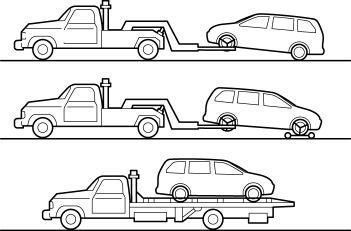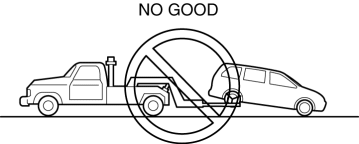Mazda CX-5 Service & Repair Manual: Towing
Towing Description
-
Proper lifting and towing are necessary to prevent damage to the vehicle. Government and local laws must be followed.
-
A towed vehicle usually should have its drive wheels (front wheels) off the ground. If excessive damage or other conditions prevent this, use wheel dollies.
-
When towing with the rear wheels on the ground, release the parking brake.

CAUTION:
-
Do not tow the vehicle pointed backward with driving wheels on the ground. This may cause internal damage to the transaxle.

CAUTION:
-
Do not tow with sling?type equipment. This could damage vehicle. Use wheel?lift or flatbed equipment.

Vehicle Securing Position
-
When transporting the vehicle by flat bed tow truck or trailer, secure the vehicle to the trailer using the holes and left tiedown loop shown in the figure.

CAUTION:
-
Do not use the tie down hook on the end of the rear bumper for towing or transporting the vehicle. The tie down hook is used only for transporting the vehicle by ship. Using the tie down hook could cause damage to the bumper and the vehicle body.
-
 Trailer
Trailer
...
 Body
Body
...
Other materials:
Front Stabilizer Control Link Inspection
1. Remove the front stabilizer control link..
2. Inspect for bending or damage. If there is any malfunction, replace the front
stabilizer control link.
3. Rotate the front stabilizer control link ball joint stud 10 times and
shake it side to side 10 times.
4. Measure the front stabilizer c ...
Tire Pressure Monitoring System Warning Light
Purpose, Function
The tire pressure monitoring system warning light notifies the driver that
it was determined that a tire pressure has decreased below the specified value
based on the initialization.
The tire pressure monitoring system warning light notifies the driver that
...
Start Stop Unit Inspection
1. Remove the following parts:
a. Column cover.
2. Verify that the voltages of each of the terminals are as indicated in the
terminal voltage table (reference).
If the voltage is not as specified in the terminal voltage table (reference),
inspect the parts under Inspection item(s) a ...
